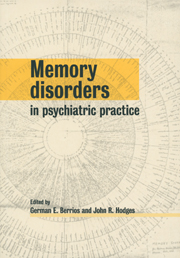Book contents
- Frontmatter
- Contents
- List of contributors
- Preface
- Part I
- Part II
- Part III
- 14 Paramnesias and delusions of memory
- 15 Déjà vu and jamais vu
- 16 Confabulations
- 17 Flashbulb and flashback memories
- 18 Functional memory complaints: hypochondria and disorganization
- 19 Dissociative amnesia: re-remembering traumatic memories
- 20 Recovered and false memories
- 21 The Ganser syndrome
- 22 Malingering and feigned memory disorders
- 23 Legal aspects of memory disorders
- Notes
- Index
15 - Déjà vu and jamais vu
from Part III
Published online by Cambridge University Press: 06 January 2010
- Frontmatter
- Contents
- List of contributors
- Preface
- Part I
- Part II
- Part III
- 14 Paramnesias and delusions of memory
- 15 Déjà vu and jamais vu
- 16 Confabulations
- 17 Flashbulb and flashback memories
- 18 Functional memory complaints: hypochondria and disorganization
- 19 Dissociative amnesia: re-remembering traumatic memories
- 20 Recovered and false memories
- 21 The Ganser syndrome
- 22 Malingering and feigned memory disorders
- 23 Legal aspects of memory disorders
- Notes
- Index
Summary
This chapter is concerned with two types of paramnesia: déjà vu and jamais vu. Paramnesia, a term which is nowadays rarely used in medical practice (Berrios, 1995), refers to a group of memory anomalies associated with both non-pathological and pathological conditions (see Chapter 14, this volume). It is to be regretted that current interest in memory disorders tends to focus on memory loss (as in the amnestic syndrome and dementia) to the detriment of the study of the paramnesias. Indeed, clinicians with little free time on their hands to keep up with the theoretical literature on memory disorders should be able to use the paramnesias as a vantage point to study the processes of memory. After discussing divergent views on, and describing some types of, ‘paramnesia’, this chapter will deal with the clinical features of the déjà vu and jamais vu experiences.
Paramnesia
Paramnesia denotes false memory. The term derives from the Greek para-, meaning from (the side), beside near, beyond, against, and -mnesis, meaning memory (Campbell, 1996). The term paramnesia was coined by Emil Kraepelin (1887) in analogy of terms such as paranoia, paraphasia and paraphrenia, as a general term ‘to denote pseudoreminiscences or illusions and hallucinations of memory’ (Burnham, 1889). Following James Sully's book Illusions (1881), Kraepelin (1887) differentiated between a total (völlige Erinnerungsfälschung) and a partial (‘theilweise Erinnerungsverfälschung’) form of paramnesia. The latter form is based on distortions or elaborations of real events, the former emerges independent of any real events of personal history. By comparison with perception disorders, the partial form corresponds with illusions and the total form with hallucinations.
- Type
- Chapter
- Information
- Memory Disorders in Psychiatric Practice , pp. 338 - 347Publisher: Cambridge University PressPrint publication year: 2000
- 5
- Cited by

